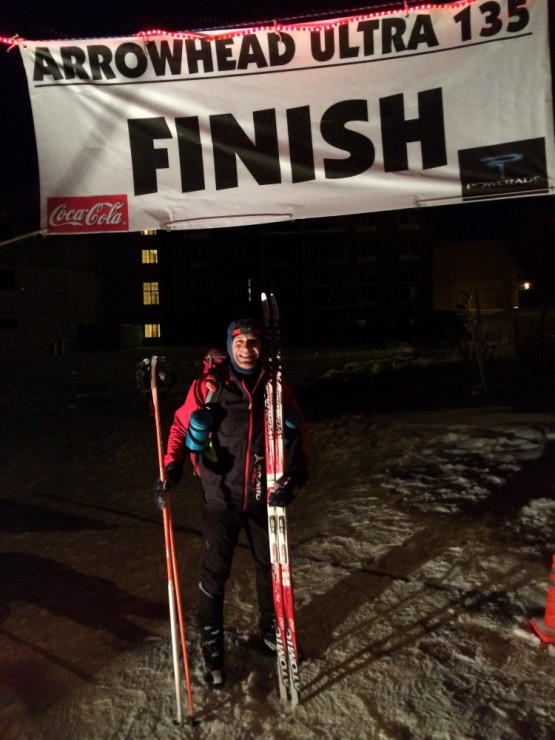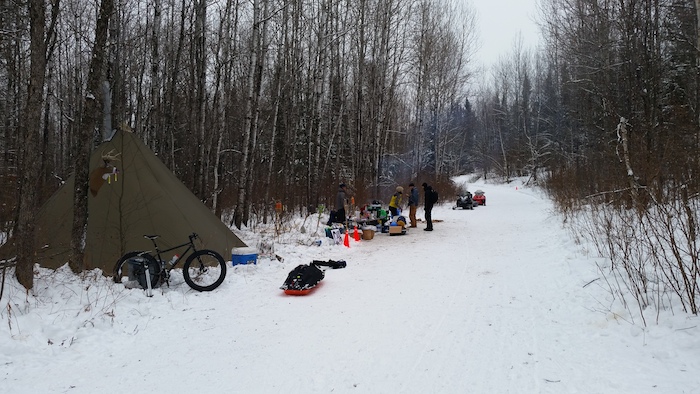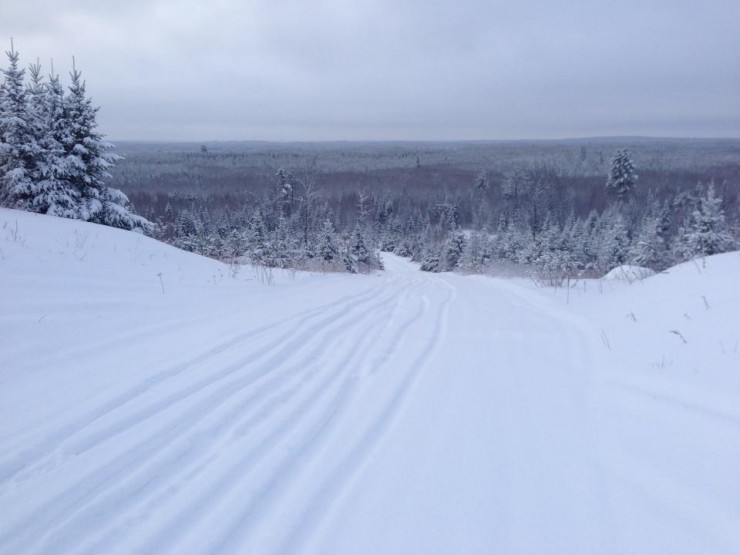
Think of the Arrowhead 135 as a rogue “ultra” within the niche world of wintertime endurance races. As the name suggests, it’s a 135-mile long, human-powered event. Racers can choose as late as race day to propel themselves on foot, bike or skis. The race route starts in International Falls, Minn., spitting distance to Canada, follows the Arrowhead snowmobile trails, and finishes a long ways east and south at Lake Vermillion’s Fortune Bay Casino.
But before we get to the race details that promote self-supported winter travel, let’s get to the crux for eventual ski-category winner, Mike Brumbaugh of Minneapolis, twenty miles into this year’s race on January 25. That’s where Brumbaugh snapped his pole.
The Arrowhead Trail, on low-snow years like this year, can be a bit rough.
“It’s just the luck of the draw whether it’s groomed or not,” race director Ken Krueger explained on the phone. “They do not groom for us.”
With thin snow and a lack of mowing during the snow-free months, Brumbaugh said one- to two-foot tall willow saplings made skate skiing difficult.
“I thought I had put my ski down on the inside of them, and unfortunately my tip caught one and my ski just ripped the right one, and I was V2-ing,” Brumbaugh recalled on the phone earlier this month. “I had already committed, I already had the pole coming down, and it just got on the inside of my binding and I sheared it off with my knee.”
A pole break may not be such a big deal at a local race, but with another 16 miles until a race checkpoint, things got a little desperate.
“When I broke it at twenty miles, I stopped and stuck a stick in each end, put it together,” Brumbaugh said of his McGuyvered ski pole. “One of the bikers stopped right away and had some duct tape. We tried it. I went with it for a little bit. But as soon as I really put any pressure on it, it just snapped it again. Then I just carried it for sixteen miles.”

Pretty much in the middle of nowhere, Brumbaugh lacked choices.
“It was better than the alternative, not having a pole,” he said. “The sixteen miles I did with just one pole, that took a lot out of me. Because you are just one-siding all the way.”
At the race’s first checkpoint, a general store/gas station, racers are allowed to purchase anything the store has for sale. Brumbaugh asked if they had any type of hiking pole or ski pole available. Negative. They did carry fishing poles, but none looked strong enough.
“I asked, ‘Do you have any PVC pipe around or anything?’ ‘Yeah we got a bunch of stock in the back of the building on a rack.’ So I went back there started sticking the top end into a bunch of pipe and I found one that was really snug and so I grabbed it and carried it to the store.”
After cutting the PVC to a suitable length, Brumbaugh inserted the pipe into the two sections of pole.
“Then I went and bought some fiber tape they had on the wall there,” he said. “I taped up the top end and I taped up the bottom, at least I had something to ski with for the whole 99 miles.”
Awkward swing weight aside, Brumbaugh made the best of it.
“Everything was good except when you bring your hands up to V2, the extra weight on the pole would swing forward beyond the vertical,” he explained. “And so I had to start holding it back with just my hand, my wrist. After about 40 miles of that, it got real tiring. So then I stopped at the next checkpoint and I actually switched my grips from one to the other so I did that to give myself a rest.”
Sustained rest is something Brumbaugh lacked on his journey. He never slept. Despite the equipment setback, imperfect trail conditions and a debilitating bonk a half mile from the end — 22 hours after starting, Brumbaugh finished. He did so in record time for a skier, besting the old mark by five minutes.
Brumbaugh was the ninth-place overall finisher and first-place skier out of two men. Everyone who finished ahead of Brumbaugh rode fat bikes.

Asked why so few skiers enter the Arrowhead 135, Krueger noted the often rustic trail conditions and the self-supported nature of the race.
“It’s really hard to find the right conditons to ski,” he said. “And not a lot of people have that skill set.”
Krueger, a seven-time race finisher and one of nine people to have completed the race on foot, bike and skis, says the low percent finishing rate tells that story.
Of the 12 race editions, only 50 people have started on skis.
“Skiing has a 46-percent finish rate- only 23 people have ever done it,” Krueger said. “Of the 23 finishers, seven of them were in one year.”
Racers are required to carry a minimum of gear, much of which allows for successful overnighting in what can be well-below-zero temperatures. That includes things like a negative 20-degree sleeping bag, a stove for melting water, and enough calories for a sixty hour journey; the race has a 60-hour cutoff time.
“When I broke it at twenty miles, I stopped and stuck a stick in each end, put it together. … As soon as I really put any pressure on it, I just snapped it again. Then I just carried it for sixteen miles.” — Mike Brumbaugh, 2016 Arrowhead 135 ski winner, on breaking a pole 20 miles in
During Krueger’s first Arrowhead 135, cold Arctic air was the norm.
“I was 54 hours, and it was about zero for one hour of that 54,” Krueger explained. “It was -28 below at the start, 35 below the first night. Just brutal, brutal cold.”
For Brumbaugh, who has completed 23 Birkies, the Swedish Vasaloppet, and the two-day, 170 kilometer Canadian Ski Marathon, he simply wanted to do a race longer than he’d ever done before.
“That’s what drew me to it,” Brumbaugh said about his motivation. “This was right here in my home state. And I started looking at the high failure rate and I probably knew about ten people here in town that had done it, only one of them ever finished it. All the rest, the first couple of times, they always failed. And I thought, you know what? I’d like to ski.”
Brumbaugh’s ski pack was 22 pounds — including the mandatory LED lighting for night travel — and he skated the entire 135 miles.
If you want in, you’ll have to prove your muster to race organizers.
Krueger says race applicants are exactly that, applicants. Entrants must have completed a pre-qualifying race demonstrating they can handle rugged-and-cold winter conditions.
“We limit our roster, we target about 150 starters. So this year we had 166 lined up and we started 151. So we fill up right away,” he said. “We don’t market or advertise or anything. Tenets of the race are strength, endurance, and survival. We don’t want a thousand people out there because it becomes a different race.”
This year, 58 bikers, 28 runners and two skiers participated.
“One guy says, ‘I haven’t seen a guy for ten hours.’ Yeah, you aren’t supposed to,” Krueger continued. “It’s about you and the trail. Not if some guy is five minutes behind me.”
Asked if he has ever had to turn back an unprepared racer mid-race, Krueger stated the Arrowhead itself is a gatekeeper. “No. The trail takes care of that for us,” he said.
The race rules dictate that participants may receive no outside help except from other racers or race officials.
So remember to bring cash to fix the broken pole.
Jason Albert
Jason lives in Bend, Ore., and can often be seen chasing his two boys around town. He’s a self-proclaimed audio geek. That all started back in the early 1990s when he convinced a naive public radio editor he should report a story from Alaska’s, Ruth Gorge. Now, Jason’s common companion is his field-recording gear.
